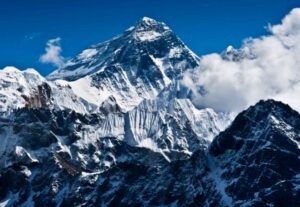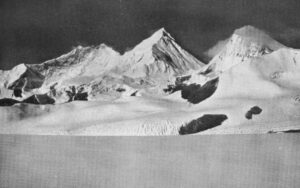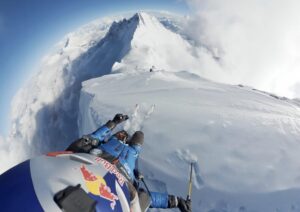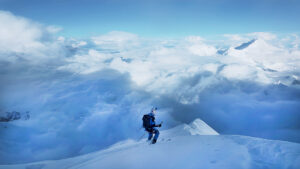Climbing Everest, Lhotse, and Nuptse in a single season is so rare that only four people have done it. Each peak has its own difficulties, but Nuptse is the least familiar and most technical, even for oxygen-assisted climbers on fixed ropes.
Jay Whiting of the UK and Dawa Tenji Sherpa completed this Triple Crown this spring. It made Whiting only the second Briton to complete it in one season, after guide Kenton Cool, and the fourth person overall. At 33, he is also the youngest. But most remarkably, the guy in front of him, Dawa Tenji Sherpa, has now done it twice.
PART I: CONTEXT
Sharp and technical
Nuptse is sharp, technical, unforgiving, and dangerous if conditions are not right. At 7,861m, it is an almost-8,000’er. Consider: Until the end of 2024, a total of 12,884 people had summited Everest, including 9,156 from the Nepalese side. Only 38 had summited Nuptse, according to The Himalayan Database.
Since Denis Davis and Tashi Sherpa first stood on Nuptse’s summit in 1961, it has attracted some of the best high-altitude climbers in the world. There have been epic, alpine-style ascents on new routes, from Doug Scott and Al Rouse’s on the North Face in 1979 — only the second ascent — to Ueli Steck’s ill-fated last solo in 2017.
Then, there are the Piolet d’Or-winning lines: the South Face by France’s Helias Millerioux, Frederic Degoulet, and Ben Guigonnet in 2017, or Valery Babanov and Yuri Koshelenko’s climb via the Southwest Buttress to the slightly lower East summit in 2004.
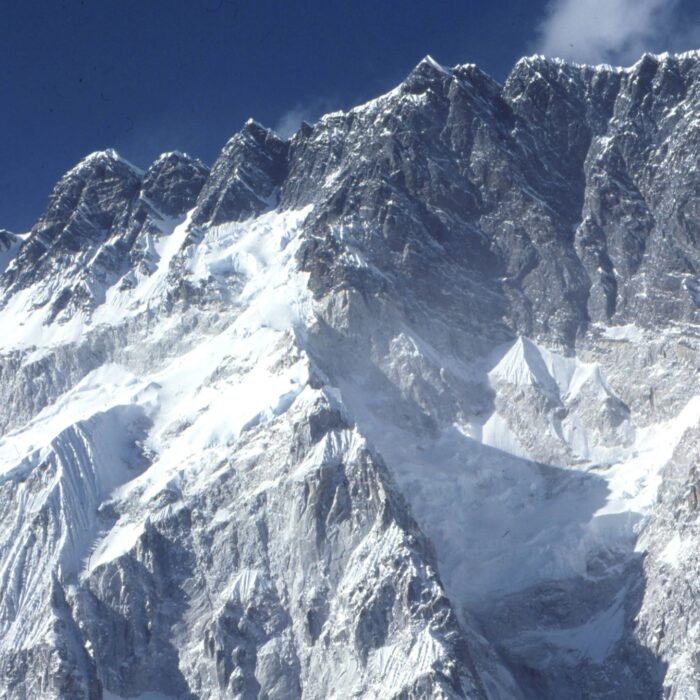
Nuptse. Photo: Valery Babanov
Other meritable climbs ended unsuccessfully. The mountain defeated Tomaz Humar (whose partner, Janez Jeglic, was blown off the mountain to his death), and the strong team of Steve House, Barry Blanchard, Steven Koch, and Marko Prezelj.
Until recently, the peak was climbed without supplemental oxygen. The North Ridge, accessed from the Camp 2 common to Everest and Lhotse, was hardly a typical “normal” route. Success only seemed within reach of such excellent climbers as David Goettler, Gerlinde Kaltenbrunner, the Benegas Brothers, Alex Txikon, Ralf Dujmovits, Kenton Cool, and Pete Athans.
Outfitters ignore Nuptse
Since the beginning of commercial expeditions in the 1990s, outfitters usually ignored Nuptse for practical reasons. It was too hard, and it lacked the commercial appeal of an 8,000m peak.
The idea of a Triple Crown was unknown. Climbing Everest, Lhotse, and Nuptse was a lifetime goal, not a seasonal one. The first to climb all three was Ralf Dujmovits of Germany, who summited Everest in 1992, Nuptse in 1996, and Lhotse in 2009.
In the spring of 2013, guide Kenton Cool climbed all three in the same season for the first time. His Nuptse summit was controversial for a while because Alex Txikon of Spain, who was with him, initially believed that they had not reached the highest point.
While others on the team stopped at a point they thought was the top, Cool and Txikon continued along the knife-edged summit ridge. Txikon thought they went up as far as possible, but that there remained some 150m to go.
However, Txikon changed his mind years later, as he told ExplorersWeb in 2022. After we posted that story, Txikon discussed the matter with Cool and with Billi Bierling of The Himalayan Database, and cleared up the facts. Both Cool and Txikon now appear in The Himalayan Database as Nuptse summiters. Both did their climb without oxygen.
The final ridge
When asked about it, Jay Whiting explained that the true summit of Nuptse can be confusing but can be identified if enough summit pictures are provided. He supports the validity of Alex Txikon and Kenton Cool’s summit.
Whiting explained that some people may stop at a small shoulder on the summit ridge, photo below, but the true summit is well beyond.

Climbers on the summit ridge of Nuptse. Photo: Jay Whiting
“The final traverse is on a knife-edged, corniced ridge,” he explained. Whiting was able to record part of the (terrifying!) traverse while holding the ropes and using his cell phone on a selfie stick at the same time:
Whiting believes that despite the 38 official ascents, only a handful of climbers have reached the true summit of Nuptse. Many others, he believes, stopped a little short.
Fixed ropes and oxygen
After a few failed attempts, the first fully guided team to succeed on Nuptse was led by Garrett Madison of the U.S. just two years ago. All clients used bottled oxygen, and a Sherpa team fixed the route. Madison and two clients, supported by five Sherpas, reached the top on May 8, 2023. Garrett Madison and one of the rope-fixers, Dawa Tenji Sherpa, also summited Everest and Lhotse that same spring, thus completing the Triple Crown.
At the beginning of 2025, only Madison, Dawa Tenji Sherpa, and Kenton Cool had completed this Triple Crown. Then came Jay Whiting, a 33-year-old British solicitor. He was not a professional climber or an athlete. Coincidentally, Kenton Cool was at Everest Base Camp and discussed the challenge with Whiting.
Whiting was on his second try to climb Nuptse after a failed attempt in 2022. This time, he knew the right man to rope up with: Dawa Tenji Sherpa. Together, they summited Nuptse on May 12, Lhotse on May 20, and Everest on May 23.
PART II: THE 2025 TRIPLE CROWN
Dawa Tenji’s last Nuptse
That day, Whiting became the second Briton and the fourth person to complete this so-called Triple Crown. Meanwhile, Dawa Tenji Sherpa had now done it twice. He is also the only climber to have summited Nuptse three times.
“Tenji [Sherpa] is the man that everyone turns to for fixing the route on Nuptse,” Whiting told ExplorersWeb. Among his other advantages, Dawa Tenji Sherpa knows exactly where the true summit is.
“Nuptse is considered one of the most technical climbs in the region, and I feel truly honored to have summited it three times,” Dawa Tenji Sherpa said. It seems, however, that three is more than enough for him.
“I am thinking I won’t guide on Nuptse again,” Dawa Tenji Sherpa told ExplorersWeb.
He won’t have problems getting other work. In the last decade, besides his three Nuptse summits, Dawa Tenji has summited Everest four times and Lhotse three times. He has also reached the top of K2, Cho Oyu (twice), Dhaulagiri, and Ama Dablam. He has formal training in advanced mountaineering, high-mountain rescue and first aid, helicopter marshaling, and rock climbing. And he is just 30 years old.
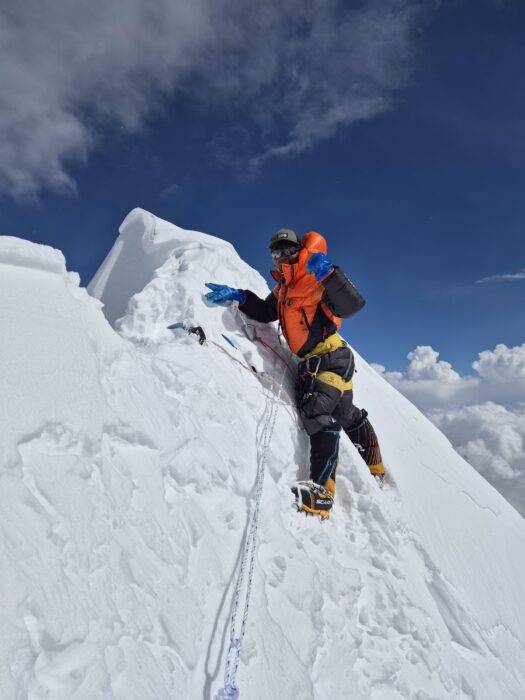
Dawa Tenji Sherpa fixes ropes on the summit ridge of Nuptse. Photo: Jay Whiting
Dawa Tenji Sherpa works for Himalayan Guides. We asked the Nepal-based outfitter whether Nuptse is an option for commercial teams.
“While Nuptse is a more technical peak, we are open to organizing guided ascents under suitable conditions, as long as we have a minimum of four clients,” director Iswari Paudel told ExplorersWeb. “However, we prefer not to take the risk just for a single client, because a minimum of five technically experienced fixing staff is required for a safe and successful climb, unless that single client can afford the [entire] cost.”
Strategy
Nuptse, Lhotse, and Everest form a single massif, but they provide very different climbing experiences. While the first two host hundreds of climbers, Nuptse is lonely and hostile.
“Nuptse, in particular, is often underestimated,” said Dawa Tenji. “[It] is technically far more difficult, the route is steep, exposed, and demands precision on mixed terrain — rock, snow, and ice. The weather can be very unpredictable, and the summit ridge is sharp and dangerous.”
Despite its difficulty, it is often planned as the first goal of the season. It requires a devoted Sherpa team, who can start fixing the route as soon as the passage through the Khumbu Icefall is open and Camp 2 (common to all three mountains) is established. Nuptse is climbed from that point and up the north ridge, with a high camp midway.
“If the first Nuptse attempt fails due to confusion about the true summit and/or bad weather, a second attempt is possible if weather and time allow,” Dawa Tenji explained. “But once Everest and Lhotse windows open, they become the priority and Nuptse is usually dropped.”
He added:
“Right after Nuptse, climbers usually summit Lhotse and Everest back-to-back from Camp 4, taking advantage of the same acclimatization and weather window.”

Nutpse summit. Photo: Jay Whiting
Windy climbing
Jay Whiting teamed up with Dawa Tenji for the season, but they climbed Nuptse in a larger group that included other Sherpa staff and clients. Whiting’s climbing partner from 2022, Steve Graham, was also there.
“Mainly, I led the fixing line, but there were also Sherpas working with Glacier Himalayan and Asian Trekking,” said Dawa Tenji.
“We reached the true summit after about 15 hours from the high camp,” Whiting told ExplorersWeb. “[Dawa] Tenji, Chheten Dorje Sherpa, and Temba Sherpa fixed the ropes.”
Like everyone in the Khumbu this season, they had to deal with high winds on the upper sections.
“The weather was very bad this year, and forecasts weren’t getting it right,” Whiting said. “We had high winds on Nuptse on May 12 [see video above] and Lhotse was also 30-40 knots.”
On Lhotse, Whiting noted that a large group ahead of them had turned around. “But we continued into the couloir and once we were there, the wind went down, and we had the summit to ourselves.”
The hardest day was May 23 on Everest. That day, several groups turned around.
“I’d say 90% of people [ahead of us] turned around at the Balcony, but again we pressed on to have a look for ourselves and luckily, the winds abated,” Whiting said.
So the climbers met almost no one else on the sometimes crowded summit ridge. Below, a video of the wind at Everest’s Balcony:
“Climbing with Jay [Whiting] was good,” Dawa Tenji said. “He’s strong, focused, and listens well on the mountain.
More Triple Crowns ahead?
Asked if the Triple Crown might appeal to other commercial climbers looking for a new goal, Whiting was not so sure, mainly because of the challenges of Nuptse.
“To date, [Dawa] Tenji is the only person who has fixed ropes to the true summit,” he said. “Also, it’s just under 8,000m and is very hard compared to Everest and Lhotse, so that makes Nuptse not as attractive.”
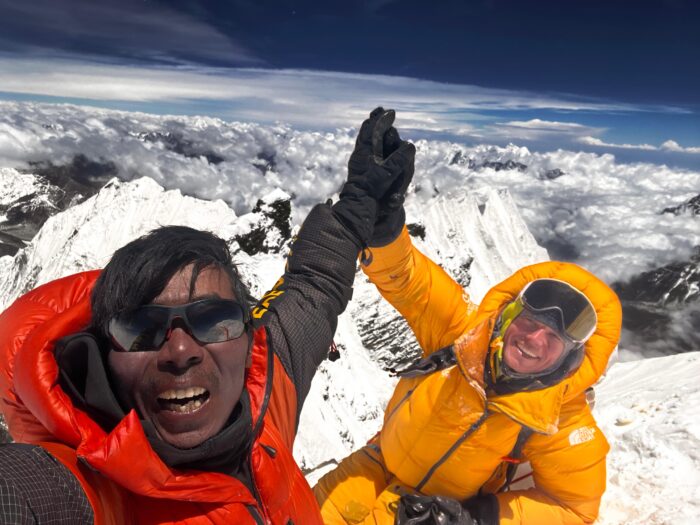
Dawa Tenji Sherpa, left, and Jay Whiting on a summit. Photo: Dawa Tenji Sherpa
For Whiting, however, it’s just the opposite.
“I would certainly choose to climb Nuptse out of the three due to the lack of crowds. It is more of a proper climb.”
For the future, the British climber hopes to do more alpinistic ventures.
“I’d like to explore more remote regions and climb some smaller, less frequented peaks in alpine style on a small team, but I’m not a full-time mountain professional and have to juggle my job with these trips,” he said.
Not for everyone
For those reading this story and wondering about following in Jay Whiting’s footsteps, they should consider the difficulties of the Triple Crown. Ropes and oxygen will help, but they can’t perform miracles.
“I think the Everest-Lhotse double-header is well established, and people are used to hearing about it. However, the wild card is Nuptse,” Whiting said. “A problem at the summit ridge or the summit could have serious consequences if something went wrong. There are some very technical sections on the North Ridge of Nuptse, beyond what you’d find on Everest or Lhotse. Those tackling the climb would have to be prepared and experienced.”
Whiting also noted that climbing the three peaks is utterly exhausting. “I trained for two years with expert coaching,” he said.
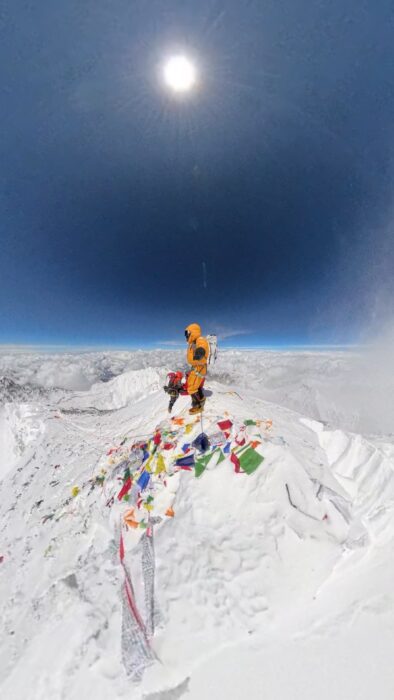
Jay Whiting alone on the summit of Everest, May 23, 2025. Photo: Dawa Tenji Sherpa
The ultimate challenge
Now, imagine trying it without supplementary oxygen. The challenge would be huge, not only because of the exhaustion, cold, and technical difficulties, but also having to remain at nearly 8,000m for an extended time during the Lhotse-Everest leg.
Yet the impossible made possible is a motto among Everest climbers. In 2021, Kilian Jornet of Spain and David Goettler of Germany showed up in Everest Base Camp but kept quiet about their plans. Rumors hinted that they might attempt something never seen before: the so-called Horseshoe Traverse, summiting Everest, Lhotse, and Nuptse, without oxygen and along the ridgeline, instead of descending to lower camps.
The climbers finally retreated from the South Col without reaching any summit. (It was the year of COVID.) But it may be only a matter of time before someone dares to tackle this ultimate challenge.

